


Super Heterodyne Recievers from 1946 to 1948
After WW II, Allied Powers lifted the ban on the short wave listening.
It’s 18/09/1945, only a month after from occupation and a week before AFRS starting.
As a tool for democratization, GHQ needed prevailing of radio.
Many radio set was lost by war. GHQ commanded increasing production of
radio sets and tubes.
Radio industry manufactured low cost TRF sets first.
At the spring of 1946, Many high-grade super heterodyne and all wave set was released.
If these set developed after end of the war, it’s too fast.
Until 1945, The production of super heterodyne set was limited.
Few All wave set was manufactured only military use or a few export model
only.
However, Japanese radio manufacturer continued development of super heterodyne
and all wave set at wartime.
All wave set was too expensive to ordinary people. Main stream of Japanese
radio set was TRF set.
Communication Equipment Manufacturer’s Association (CEMA) planned standardization of high-grade super heterodyne and all wave set.
The draft of standard was released, but the standard of all wave set was not authorized.
Many venture companies entered into radio industry after the war.
The big businesses changed their business from munition industries into
peacetime industries.
They manufactured radios and other subsistence commodities to keep their
companies.
The price of hi-end radio and radio phonograph made by factory was very
expensive by high commodity tax rate.
Many amateurs and engineers built or repaired own radios using surplus and used parts.
A part of them who had business skill established own companies.
They grew up into big businesses of Japanese electronics industries.
Sony typifies them.
Circuit of super heterodyne set did not standardized.
A lack of tubes for super heterodyne was terrible.
Manufacturers developed unique circuit to use tubes and parts could get
easily.
At 16/09/1947, CEMA authorized the standard of “Super Class” Kokumin-gata Receiver as upper class of TRF Kokumin-gata Receiver.
The TRF "Kokumin-gata" radio called "Regular Class".
This standard established technical standard of Japanese super heterodyne radio.
In 1948, New tubes for super heterodyne was released.
6WC5 was ST shaped converter tube similar to 6SA7.
6ZDH3 was variation model of 75 with single diode unit (Early model called 75A).
6ZDH3A was variation model that was modified into single-ended from 6ZDH3.
6WC5 and 6ZDH3A became de facto standard of Japanese super heterodyne.
6WC5 had enough specification at short wave listening.
And mass production of permanent dynamic speaker started.
Small power tube 6ZP1 and standard half wave rectifier tube 12F could be used instead of 42 and 80.
The cost of super heterodyne set was decreased.
After 1948, manufacturer put the low cost super heterodyne set (B.C. band only) on the market.
NOTICE:
Gothic is latest updates.
Japanese terms or company
names that is untranslatable are shown in spelled in Italics.
When not mentioned specially, all set are Super Heterodyne, all prices
are original retail price.
All Wave Super Heterodyne Sets
Televian Model 210 2 Band 5 tubes 1946? Yamanaka Electric Co., Ltd.
TEN Model DR-207 2 Band 7 tubes 1947 Kawanishi Kikai Seisakusho Ltd.
Concertone Model unknown 5 tubes 2 Band 1947? Tone Musen K.K.
Totsu Model TR-43 6 tubes 2 Band 1947 Toyo Communications Machinery Co., Ltd.
Totsu Model RS-61 6 tubes 2 Band 1948 Toyo Communications Machinery Co., Ltd.
NEC Model RG-101A Radio Phonograph with 4 Band 9 tubes 1948 Nippon Electric Co., Ltd.
National Model 8A-1 3 Band 8 tubes 1946-48 Matsushita Electric Ind. Co., Ltd. Wireless MFG.
Dept.
SINE All Wave Receiver 3 Band 5 tubes 1946-7 International Telecommunications Co., Ltd.
Royal Model DAT-62 2 Band 6 tubes 1946 Harasaki Radio MFG. Co., Ltd.
JRC Model R-102 2 Band 5 tubes 1946 Japan Radio Co., Ltd.
JRC NMR-124 2 Band 5 tubes 1946 Japan Radio Co., Ltd.
Toshiba Model ZS-1004A 3 Band 7 tubes 1946-47 Tokyo Shibaura Electric Co., Ltd.
Toshiba Model ZS-1004C 3 Band 7 tubes 1947-48 Tokyo Shibaura Electric Co., Ltd.
NEC Model RA-100B 2 Band 6 tubes 1947 Nippon Electric Co., Ltd.
Victor Model 5AW-1 "Reimei" 5 Band 5 tubes 1946 Victor Company of Japan Ltd.
2 Band 5 tubes Super Heterodyne 1947? mfr: unknown
PHILIPS Model 31?7X 3 Band 6 tubes 1948, mfr: unknown
BC Band Super Heterodyne Sets
NOBLE Radio type 203 (Model NR-203) 5 tubes 1946 Teikoku Tsushin Kogyo Co., Ltd.
TEN Model DR-105 5 tubes 1946 Kawanishi Kikai Seisakusho Ltd.
Nanaola Model NH-5062 4 tubes 1947 Nanao Radio Co.,Ltd.
Nanaola Kokumin-gata Super 5 tubes 1948 Nanao Radio Co.,Ltd.
Televian Model R-50 5 tubes 1947? Yamanaka Electric Co., Ltd.
JRC Model R-101 5 tubes 1946 Japan Radio Co., Ltd
MEC MODEL 1001 5 tubes 1948? Mikuni Electric Co.,
FUTABA Model FKS 5 tubes 1948 Futaba Electric MFG. Co., Ltd. JPY 6197.66
Victor Model 5RS-1 5 tubes 1947 Victor Company of Japan Ltd.
All Wave Super Heterodyne Radios
Televian Model 210 2 Band All Wave 1946? Yamanaka Electric Co., Ltd.



TUBES: 6WC5-6D6-6ZDH3A-42-80 (after modified), Electro-dynamic Speaker,
Yamanaka Electric was one of the leading companies of Japanese radio industry from pre war.
This model was their early all wave set after the war.
Design was early 1940’s American style.
This example was modified from all wave into B.C. band only.
Coil, IFT, tubes, knobs and other many parts was replaced.
Metal conector behind chassis was unoriginal.
Schematic diagram did not existed. Original circuit was unknown.
(Colection No.11797)
TEN Model DR-207 2 Band All Wave 1947 Kawanishi Kikai Seisakusho Ltd.


TUBES: 6C6-6C6-6D6-6D6-75/6ZDH3-42-80 , Electro-dynamic Speaker (6.5")
Kawanishi kikai was reconverted company from war production.
6C6 and 6D6 were prevailed tubes for TRF sets.
And many 6C6, 6D6 and 75 were used for military equipment.
They probably had many stocks of such tubes and other parts for military equipment.
This set used stocked tubes dated 1944 or 1945.
Circuit was very unique, a pair of 6C6 worked as converter and local oscillator.
Chassis was made by Aluminum and hand crafted.
Kawanishi Kikai also manufactured aircraft at wartime.
They stocked aluminum for aircraft.
Cabinet was painted marble tone. Design was early 1940's American style.
Kawanishi Kikai dissolved by restrictions of the zaibatsu in 1949.
And Kobe Kogyo Ltd. was established.
Now they continued their business as Fujitsu TEN Ltd.
Some tubes were modified but kept original condition.
(Colection No.11707)
Concertone Model unknown 2 Band All Wave 1947? Tone Musen K.K.


TUBES: 6WC5-6D6-6ZDH3A-42-80 (after modified), Electro-dynamic Speaker,
Tone Musen K.K. was one of the leading companies of Japanese radio industry from pre war.
This model was their early all wave set after the war. The design of cabinet
was European style.
This example was modified into BC band set. Almost original parts were
missing. Cabinet, chassis and speaker were original.
No meme plate and labels. Model name and original circuit were unknown.
(Colection No.1111701)
Totsu Model TR-43 6 tubes 2 Band 1947 Toyo Communications Machinery Co., Ltd.
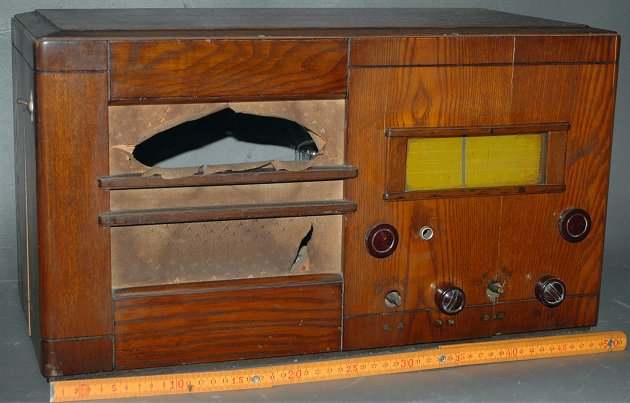
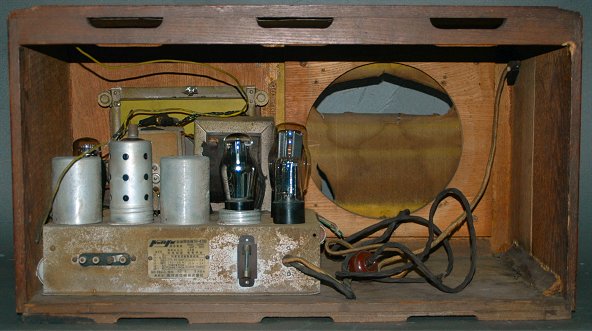
TUBES: Ut-6L7G -76-6D6-6B7-42-80, Electro-dynamic Speaker (Toyo, 8")
Toyo Communications Machinery Co. was ancient manufacturer of radio communication
equipment founded in 1891.
They entered into home radio after the war.
Ut-6L7G and 76 was used as converter and local oscillator.
This was typical circuit of Japanese all wave radio at this era.
Because quality of Japanese 6A7 was poor to use short wave receiving.
Short wave band was 6 to 18Mc.
The stability of power line was poor, primary voltage could be adjusted
3 steps (76-85-100V) by selector switch on the front panel.
Large cabinet was made by combined thin and narrow board.
They faded out from home radio and continued production of communication equipment and crystal resonator.
In 2005 they merged with the Crystal Division of Seiko Epson Co.
New company Epson Toyocom Corp continued as a leading company of crystal device.
Tubes were modified into 6WC5-6D6-6ZDH3A-42-80.
Speaker was missing.The knobs at upper area of front panel was non-original.
(Colection No.11874)
Totsu Model RS-61 2 Band All Wave 1948 Toyo Communications Machinery Co., Ltd.
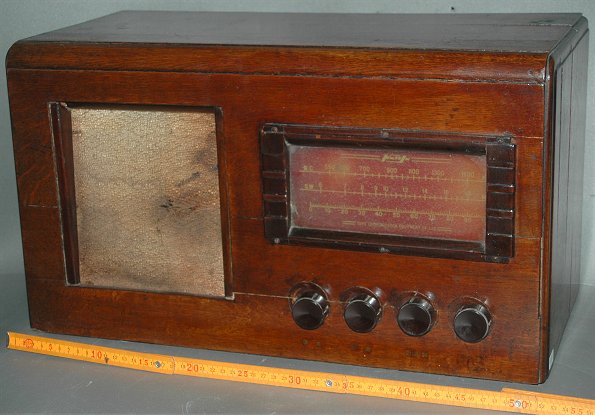


TUBES: Ut-6L7G -76-6D6-6B7-42-80, Electro-dynamic Speaker (Toyo, 8")
Toyo Communications Machinery Co. was ancient manufacturer of radio communication
equipment founded in 1891.
They entered into home radio after the war.
Ut-6L7G and 76 was used as converter and local oscillator.
This was typical circuit of Japanese all wave radio at this era.
Because quality of Japanese 6A7 was poor to use short wave receiving.
Short wave band was 6 to 18Mc.
The quality and equality of tubes were very poor. This set used adjustable
neutralizing capacitor between grid and plate of 6D6.
The capacitor could be adjust from the inspection hole of bottom.
The stability of power line was poor, primary voltage could be adjusted
3 steps (76-85-100V) by selector switch on the front panel.
Large cabinet was made by combined thin and narrow board.
They faded out from home radio and continued production of communication equipment and crystal resonator.
In 2005 they merged with the Crystal Division of Seiko Epson Co.
New company Epson Toyocom Corp continued as a leading company of crystal device.
This example was replaced coil, IFT, knobs,
Tubes were modified into 6WC5-6D6-6ZDH3A-42-80.
Speaker was replaced into permanent dynamic type (Diatone D-62)
Appeared on The Denpa Kagaku (Radio Technic & Science) 03/1948 published by Nippon Housou Shuppan Kyokai
(Colection No.11689)
NEC Model RG-101A Radio Phonograph with 4 Band All Wave 1948 Nippon Electric Co., Ltd.





Trade Mmark on the Cover
TUBES: 6D6-Ut-6L7G -76-6D6-6D6-6B7-76-76-42-42-5Z3, Electro-dynamic (10")
NEC started radio business after the war. (They manufactured radio in 1920's
and faded out)
Model RG-101A was hi-end model of NEC radios.
NEC made pick-up and phono-motor made by Matsushita was used.
Ut-6L7G and 76 was used as converter and local oscillator.
This was typical circuit of Japanese all wave radio at this era.
Because quality of Japanese 6A7 was poor to use short wave receiving.
Radio phonograph was too expensive to ordinary people.
A few rich people bought such set. This model presented to the royal family
in 1948.
Appeard on the magazine "Musen to Jikken"(The Radio Experimenter's Magagine) 01/1948 published by Seibundo-Shinkosha
National Model 8A-1 3 Band All Wave (1946-48 , Matsushita Electric Ind. Co., Ltd. Wireless MFG. Dept.) , JPY 4,500 (04/1947)


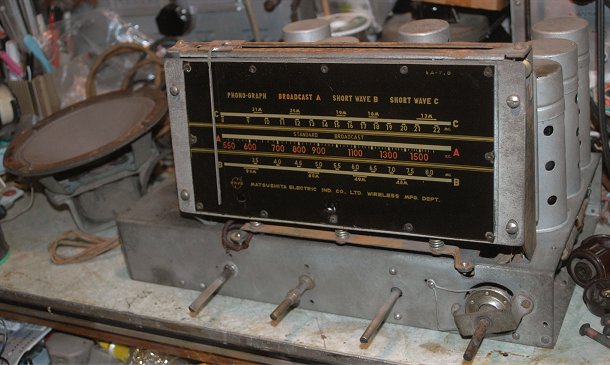
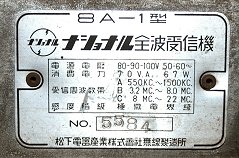
 from "Musen to Jikken" 11-12/1946
from "Musen to Jikken" 11-12/1946
TUBES: 6D6-6C6-76-6D6-76-6C6-42-80, Electro-dynamic Speaker (National Model
D-65, 6.5")
At 08/1946, Matsushita Electric put the first all wave radio Model 8A-1 on the market.
This set used gettable tubes only.
6D6 and 6C6 was prevailed for TRF set.
UY-76 was abundantly stocked in the market.
This model used strange circuit to use such tubes.
UY-76 was used as diode detector, and 6C6 was used for first audio stage.
Intermediate frequency was 455kc.
At that time standardized frequency was 463kc.
But 463kc was changed into 455kc to avoid interference with marine band in 1951.
Design of this model was suitable for Japanese market.
Similar design became de facto standard of Japanese radio later.
This unique circuit using gettable tubes probably had some plobrems.
In 1948, Model 8A-1 was full model changed into Model 8A-2.
As a variation model of 8A-1, hi-end radio phonograph Model GR-802 was
existed.
Dial was troublesome by heat from pilot lamps.
Chassis kept original condition, but some tubes was modified.
Appeard on the magazine "Musen to Jikken"(The Radio Experimenter's Magagine) 3-4/1946 published by Seibundo-Shinkosha
(prototype)
Appeared on Radio Gijyutu (Radio-Craft Monthly) magazine 04/1947 published by Kagaku-sha (Ad. on
the back cover)
(Colection No.11668)
SINE All Wave Receiver 3 Band (1946-7) International Telecommunications Co., Ltd.


(Early Model:1946) Knob was unoriginal(from private collection) Name
Plate (Later Model)
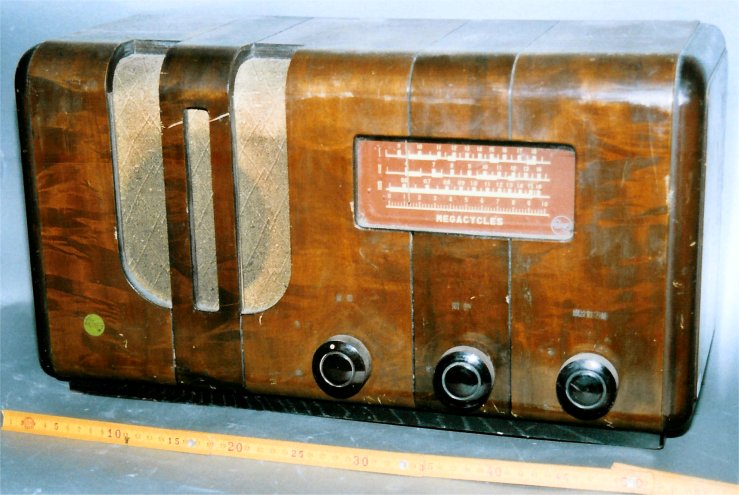

Later Model (1947) (Colection No.11568)


Varietion Model (Latest Model?) (Colection No.11796)
 (Schematic Diagram of Latest Model)
(Schematic Diagram of Latest Model)
TUBES: 6A7-6D6-6B7-42-80, Electro-dynamic Speaker
The manufacturer of this model was The Factory Division of International
Telecommunications Co., Ltd.
This factory manufactured communication receiver and transmitter from pre war era.
After the war, they entered home use radio market.
Early model equipped independent power switch. Later model used power switch with volume control.
Many military and communication grade parts dated 1944 or 1945 were used.
In 1948, International Telecommunications Co., Ltd. was dissolved.
Separated factory division became Kokusai Electric (now Hitachi Kokusai Electric Inc.).
Communication division became Kokusai Denshin Denwa Co. Ltd. (now KDDI)
Royal Model DAT-62 2 Band All Wave 1946 Harasaki Radio MFG. Co., Ltd.



TUBES: 6A7-76-6D6-6ZDH3-42-80, Electro-dynamic Speaker
Harasaki Radio was specialist for super heterodyne radio.
They manufactured super heterodyne and all wave (export model) from 1930’s.
This model was Harasaki’s first released model after the war.
Tombstone shaped cabinet became classic style at mid 1940’s.
This set took over their old products.
In 1948 this model was changed into Model DAT-64.
By the lack of tubes, this set used substitute tubes.
(Colection No.11577)
JRC Model R-102 2 Band All Wave 1946, Japan Radio Co., Ltd.


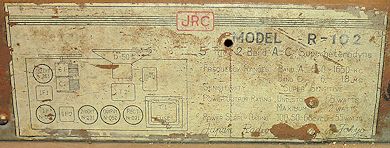
TUBES: N-361 - N-051 - N-231 - N-052 - N-021, Electro-dynamic Speaker (JRC
Model D-50), BC:550-1650kc, SW-C: 6-18Mc
This model was one of first JRC radios after the war.
Model R-102 was medium class 2 band all wave model. Upper model R-103 (3
band 7 tubes) existed.
Wooden cabinet was painted blue like Bakelite.
Own new MG tubes “N series” licensed under Telefunken Germany at wartime.
The name was changed from N series into “12G” series.
These tubes used octal base but connection was German style. Heater voltage was 12.6V
No compatibility kept with American metal or GT tube.
American metal tube was manufactured by Toshiba at wartime.
Many used American metal tubes put on the market as surplus from the occupation forces.
“12G” series was not accepted from Japanese market.
JRC stopped production of original tubes.
In 1948, they released new mode NR-5A using ordinary tubes.
The condition of this example was fear. Speaker was missing.
Tubes were replaced American metal/GT tubes and Japanese ST tube
Modified line up was 6SA7-6SK7-6SQ7-12A6-80
(Colection No.11177)
Appeard on the magazine "Musen to Jikken"(The Radio Experimenter's Magagine) 3-4/1946 published by Seibundo-Shinkosha
JRC NMR-124 Marine Radio 2 Band All Wave 1946 Japan Radio Co., Ltd.



TUBES: 6SA7 6SJ7-GT 6SJ7 6V6 5Z3 (Modified), 5"Electro-dynamic Speaker (JRC
Model D-50), BC:550-1650kc, SW-B: 1.5-4.5Mc
Variation model of R-102 for fishing boat.
Type of installed ship was unknown.
Short wave Band (1.5-4.5Mc) was different from original model (6-18Mc).
Cabinet and chassis were basically equaled to model R-102.
This example was modified in 1950’s.
Almost of original parts were missing except speaker.
Knob was unoriginal. Cabinet was fear condition.
(Colection No.11892)
Toshiba Model ZS-1004A 3 Band All Wave (1946-47 、Tokyo Shibaura Electric Co., Ltd.)


Early Model (Colection No.11662)

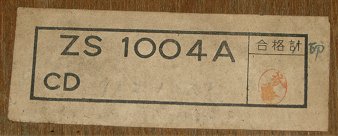
Prototype (from 85 Years of Tokyo Shibaura Electric Co., Ltd.)


Later Model Dial escautcheon and the finish of cabinet was simplified (Colection No.11020)
TUBES: 6D6-Ut-6L7G -6C6-6D6-75A(6ZDH3)-42-80, Electro-dynamic Speaker,
Intermediate frequency: 463kc.
Toshiba came back to production of radio set after the war.
A few Toshiba radio in early 1940’s was OEM supplied products.
After the war, they produced radio set at own factory.
Model ZS-1004A was one of the Toshiba’s first products and hi-end set.
Design was early 1940’s American style.
Finish was poor but construction was solid and strong.
The design of prototype was different from production model.
2 variations of cabinet existed on the production model (photo). Chassis
was no changed.
Quality was falling down in proportion to minor change by inflation and lack of material.
Documents: 85 Years of Tokyo Shibaura Electric Co., Ltd. 1963
(Colection No.11020/11662)
Toshiba Model ZS-1004C 3 Band All Wave (1947-48 、Tokyo Shibaura Electric Co., Ltd.)


TUBES: 6D6-Ut-6L7G-6C6-6D6-75A(6ZDH3)-42-80, Electro-dynamic
Speaker
Model ZS-1004C was modified model of ZS-1004A.
The shape of dial escutcheon was changed.
Chassis was no changed.
Knobs were unoriginal.
(Colection No.11862)
NEC Model RA-100B 2 Band All Wave (1947, Nippon Electric Co., Ltd.)



TUBES: Ut-6L7G -76-6D6-6B7-42-80, Electro-dynamic Speaker
Model RA-100A was the first model of NEC radio in substance.
The first model RA-100A used transformer-less circuit.
The line up of tubes were 6A7-6F7-6B7-43-25Z5-B300B (ballast lamp)
Considering power line stability and parts supply, this model probably ended up with prototype.
Model RA-100B used typical circuit of early Japanese all wave radio.
Appeard on the magazine "Musen to Jikken"(The Radio Experimenter's Magagine) 3-4/1946 published by Seibundo-Shinkosha (Model RA-100A)
(Colection No.11569、11367)
Victor Model 5AW-1 "Reimei" 5 Band All Wave (1946, Victor Company of Japan Ltd. )


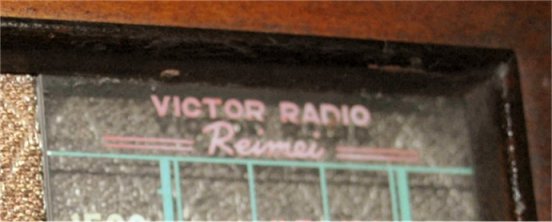
TUBES: 6A7-6D6-75-42-80, Electro-dynamic Speaker
This model was first released all wave set of Victor after the war.
The name “Reimei” means “dawn”. This name was expression of engineer’s hope to new era.
This set used 6A7 to converter. This was rare case.
The quality of Japanese 6A7 was poor to use short wave band.
Victor Co., of Japan was subsidiary of Toshiba that was biggest tube manufacturer in Japan.
And the factory of Victor placed near by the factory of Toshiba.
They probably could get high quality tubes.
Short wave band from 4 to 22Mc was separated to 4 bands to realize easy tuning.
They called “band spread”.
RCA Victor used such design in early 1940’s.
Victor Co., of Japan was subsidiary of RCA Victor until 1939.
They probably knew such design from RCA.
This model appeared on some radio magazines.
The articles included schematic diagram and technical description.
But No photo of cabinet remained.
(Colection No.11201/11624)
Appeard on the magazine "Musen to Jikken"(The Radio Experimenter's Magagine) 3-4/1946 published by Seibundo-Shinkosha
Appeared on The Denpa Kagaku (Radio Technic & Science) 01/1947 published
by Nippon Housou Shuppan Kyokai
2 Band 5 tubes Super Heterodyne mfr: unknown (1947? )
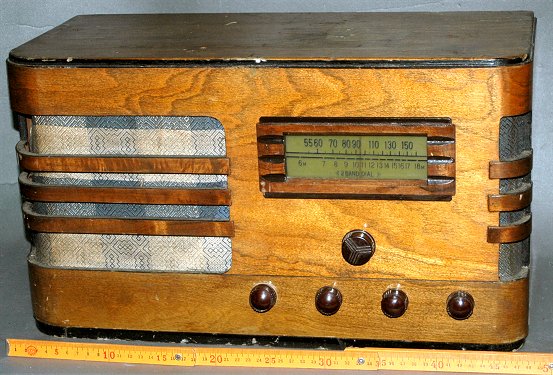

TUBES: 6A7-6D6-77-42-80, Electro-dynamic Speaker (Ashida-Vox)
This set was manufactured by small manufacturer or amateur engineer.
Strongly chassis was made by aluminum released from stocked war material.
Surplus parts from Japanese Army and Navy were used.
The design of chassis was old style but quality of construction was high.
(Colection No.11292)
PHILIPS Model 31?7X 3 Band All Wave 1948 mfr: unknown



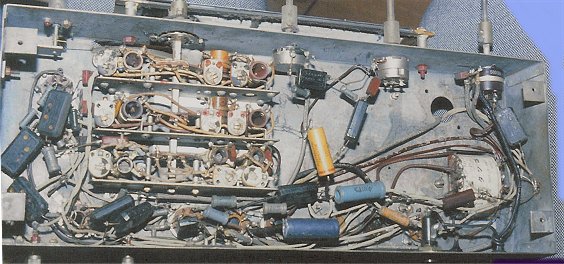
TUBES: 6SK7-12K8- ? - ? -6V6-5W4-GT - 1629, Electro-dynamic Speaker (6.5")
This large all wave set is “mystery” radio. The name “PHILIPS” was stamped
on the back of chassis.
Trademark on the dial was similar to Philips.
However, this set was not original Philips made.
Chassis and cabinet was made in Japan.
Many American military parts (may be surplus) was used.
We did not have enough information about this set.
2 tubes were missing.
(Colection No.11507)
BC Band Super Heterodyne Radios
NOBLE Radio type 203 (Model NR-203) 1946-47 Teikoku Tsushin Kogyo Co., Ltd.




TUBES: 6A7-6C6-6F7-42-12F, Electro-dynamic Speaker (Permanent Dymamic Speaker,
NOBLE Model FD-65, 6.5")
Electronics parts manufacturer Teikoku Tsushin Kogyo Co., Ltd. was established in 1944 invested by Toshiba, NEC, JRC etc.
This model was their early super heterodyne set after WW II.
Communication and military grade parts were used.
Material of chassis was alminum.
Ut-6F7 was used as detector and 1st amplifier stage.
An abundance of 6F7 was supplied as surplus from Japanese navy.
At the end of 1947, this model was changed into model NR-204.
Model NR-204 used ordinary tubes.
Teikoku Tsushin Kogyo keeps own business and grow up to large electronic
parts manufactuerer.
Left side knob was missing. Cabinet was fear condition.
(Colection No.11674)
TEN Model DR-105 5 tubes (1946 Kawanishi Kikai Seisakusho Ltd.)

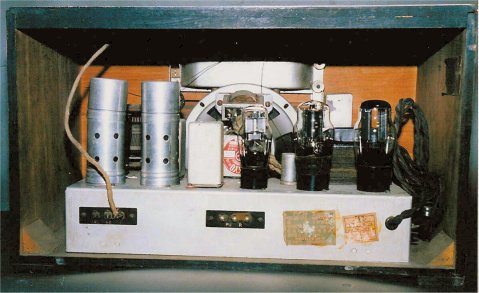

TUBES: 6A7-6D6-6F7-42-80, Electro-dynamic Speaker
Kawanishi kikai was reconverted company from war production.
6C6 and 6D6 were prevailed tubes for TRF sets.
And many 6D6 and 6F7 were used for military equipment.
They probably had many stocks of such tubes and other parts for military equipment.
This set used stocked tubes dated 1944 or 1945.
Chassis was made by Aluminum and hand crafted.
Kawanishi Kikai also manufactured aircraft at wartime.
They stocked aluminum for aircraft.
Cabinet was painted marble tone. Design was early 1940's American style.
This model was changed into Model DR-1S5 in 1948.
Kawanishi Kikai dissolved by restrictions of the zaibatsu in 1949.
And Kobe Kogyo Ltd. was established.
Now they continued their business as Fujitsu TEN Ltd.
6F7 was modified into 6ZDH3A on this example.
(Colection No.11442)
Televian Model R-50 5 tubes 1947? Yamanaka Electric Co., Ltd.

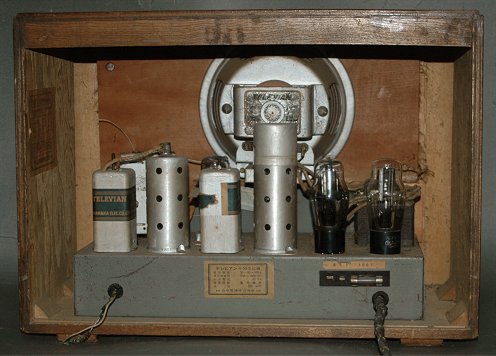

TUBES: 6A7 - 6D6 - 75 - 6ZP1 - 12F (modified into 6WC5-6D6-6ZDH3A-6ZP1-80HK),
6.5" Electro-dynamic Speaker
Yamanaka Electric was one of the leading companies of Japanese radio industry
from pre war.
This model was their early BC band super heterodyne set after the war.
(Colection No.11819)
Nanaola Model NH-5062 Semi transformer-less 4 tubes with Se Rectifier , 1947 Nanao Radio Co.,Ltd.

TUBES: 6A7 - 6D6 - 6B7 - 6Z-P1 - Se rectifier, Dynamic Speaker
Nanao Radio was one of the leading companies of Japanese radio industry
from pre war.
The circuit of this model was very unique.
The heaters of ordinary 6.3V tubes were connected series.
Auto-transformer and multiplying rectifier were used.
Rectifier device was Se rectifier.Se rectifier was put on the market instead
of lacked rectifier tubes.
However, the quality of Se rectifier was very poor. The life was shorter
than tube.
At this example, original Se rectifier and auto-transformer was replaced into ordinary transformer and rectifier tube.
(Colection No.11588)
Appeared on The Denpa Kagaku (Radio Technic & Science) 07/1947 published
by Nippon Housou Shuppan Kyokai
(Schematic diagram on the cover)
Nanaola Kokumin-gata Super 5 tubes 1948 Nanao Radio Co.,Ltd.



TUBES: 6A7 - 6D6 - 6Z-DH3 - 42 - 80 , Electro-dynamic Speaker
Nanao Radio was one of the leading companies of Japanese radio industry
from pre war.
The name “Kokumin” means “national”."Gata"means "type".
Kokumin-gata Radio was the name of Japanese standard radio set.
Almost Kokumin-gata radios were cheap TRF sets.
The name "Kokumin-gata Super" means standard super heterodyne set.
(Colection No.11871)
JRC Model R-101 5 tubes 1946 Japan Radio Co., Ltd.


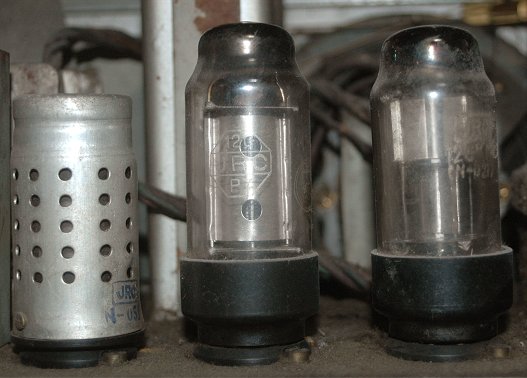
TUBES: N-051 - N-051(12GR4) - N-051 - N-052(12GP7) - N-021(12GK10), Electro-dynamic
Speaker
This model was one of first JRC radios after the war.
Model R-101 was low end B.C. only model.
Small wooden cabinet was painted like Bakelite.
Own new MG tubes “N series” licensed under Telefunken Germany at wartime.
The name was changed from N series into “12G” series.
These tubes used octal base but connection was German style. Heater voltage was 12.6V
No compatibility kept with American metal or GT tube.
American metal tube was manufactured by Toshiba at wartime.
Many used American metal tubes put on the market as surplus from the occupation forces.
“12G” series was not accepted from Japanese market.
JRC stopped production of original tubes.
In 1948, they released new mode NR-5A using ordinary tubes.
This example kept original tubes and condition.
Other example we stored was modified into ST tubes.
Some color variations existed.
(Colection No.11583,11138)
Appeard on the magazine "Musen to Jikken"(The Radio Experimenter's Magagine) 3-4/1946 published by Seibundo-Shinkosha
MEC MODEL 1001 5 tubes 1948? Mikuni Electric Co.,

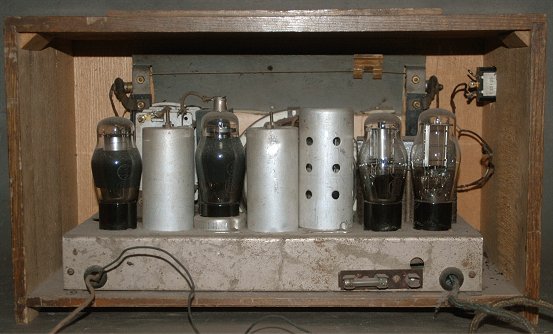
TUBES: 6WC5-6D6-6ZDH3A-6ZP1-12F, Permanent Dynamic Speaker (Nippon Seimitsu Denki, 4")
This was small manufacturer’s 5 tube super heterodyne set.
Design was early 1940’s American style.
Such design did not prevailed. It was not useful to ordinary Japanese homes.
Because radio sometimes installed at high place in Japan.
(Colection No.11213)
Futaba Model FKS 5 tubes 06/1948 Futaba Electric MFG. Co., Ltd. JPY 6197.66

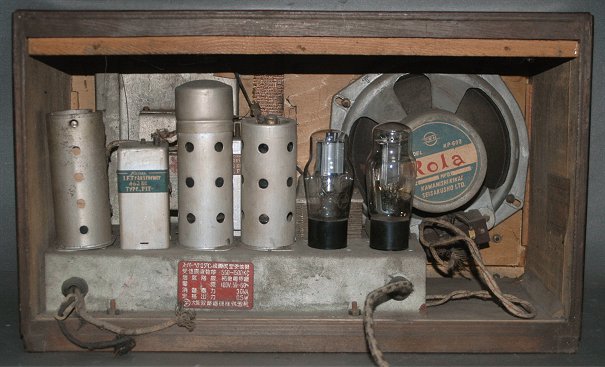

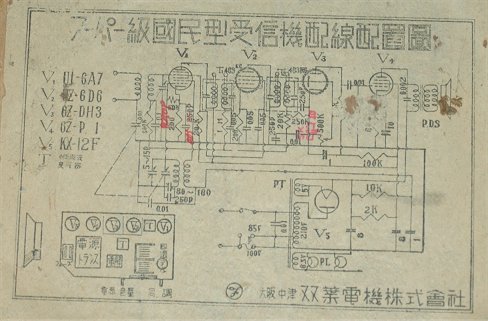
TUBES: 6A7-6D6-6ZDH3-6ZP1-12F, Permanent Dynamic Speaker (TEN Rola Model
KP-602, 6.5")
Futaba Electric was medium standing radio manufacturer from pre war era.
Auto-transformer was used to simplifieed the specificationof transformer.
Chassis was insulated from enclosure and knobs.
Because primary circuit connected directrly.
This model was Futaba's low cost model which maned "Super Class Kokumin-gata Receiver".
Kokumin-gata radio means standard radio set.
In1947, the standard of kokumin-gata radio was modified.
TRF sets of kokumin-gata radio called “regular class”.
Upper class of kokumin-gata radio was determined as “super class”.
In 1948, new converter tube 6WC5 put on the market.
The early model of this set used old 6A7.
Modification into 6WC5 was planed under developping.
Modified model with same cabinet and chassis was called FKS-2.
Appeared on The Denpa Nippon Vol.45 No.3 published by Nippon Denpa Kyokai
Appeared on The Denpa Kagaku (Radio Technic & Science) 01/1947 published
by Nippon Housou Shuppan Kyokai (Model FKS-2)
(Colection No.11766)
Victor Model 5RS-1 5 tubes 1947 Victor Company of Japan Ltd.


TUBES: 6A7 - 6D6 - 75 - 42 - 80 , Victor 6.5"Electro-dynamic Speaker
This model was first released BC band super heterodyne set of Victor after the war.
Serial Number was 876.
Appeared on Radio Gijyutu (Radio-Craft Monthly) magazine 04/1947 published by Kagaku-sha (Ad. on the cover)
(Colection No.11873)